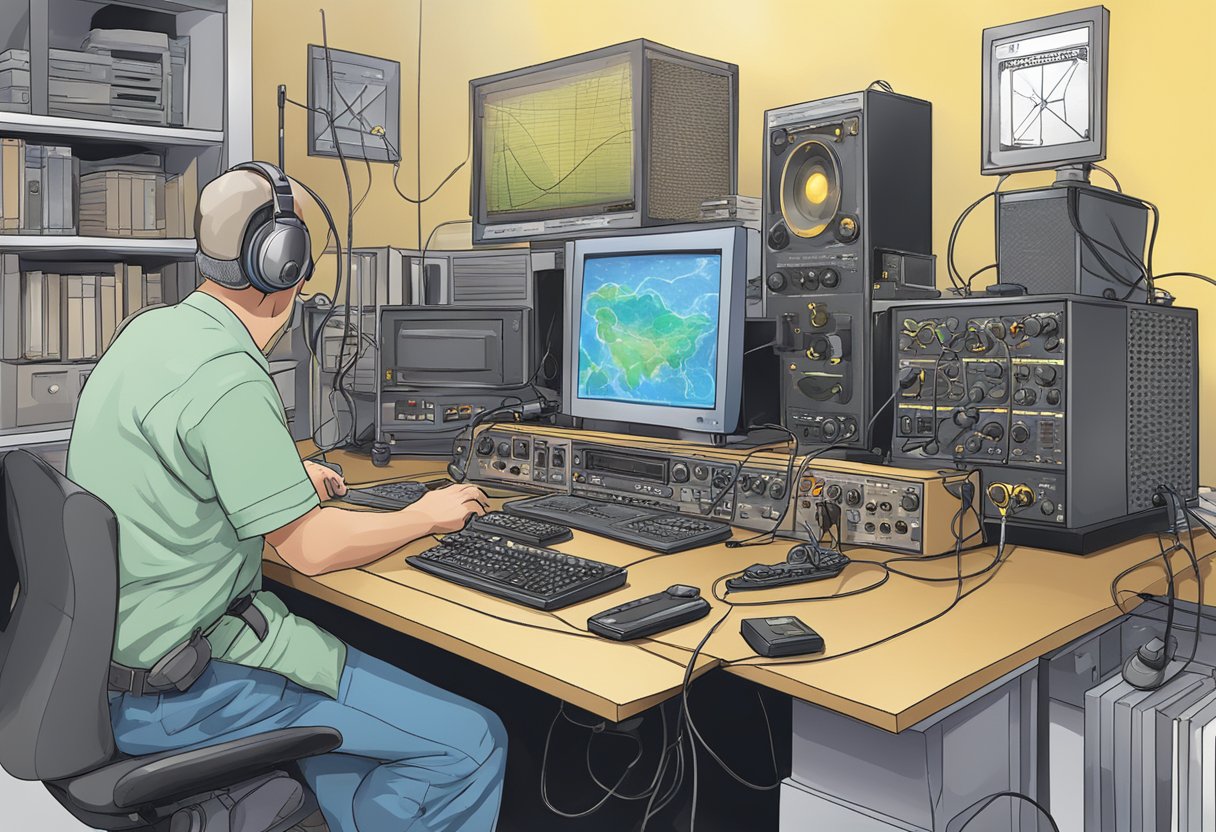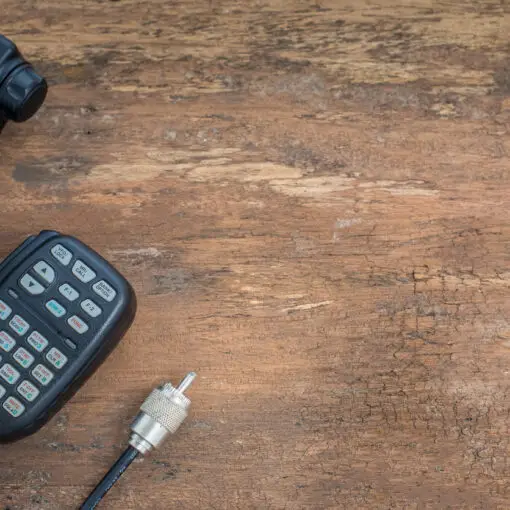Ham radio jamming is a deliberate interference with wireless communications, specifically targeting amateur radio frequencies. This intentional disruption of communication can cause major issues for ham radio operators, as it reduces the signal-to-noise ratio and renders communication difficult or even impossible. As a critical and unique medium for long-range communication, the practice of jamming ham radio frequencies has raised concerns among the radio community, governments, and international organizations.


Throughout history, incidents of ham radio jamming have been linked to political tensions, protests, and acts of aggression. These events highlight the importance of amateur radio not only for personal communication but also for its role in maintaining free flow of information and fostering international cooperation. Technological advancements have made jamming easier, but also allowed for countermeasures and intervention to protect ham radio channels.
Today, ham radio jamming continues to be a subject of interest and concern in the telecommunications industry, as well as among amateur radio enthusiasts. As communities around the world grapple with these challenges, authorities, organizations, and individual operators have come together to safeguard the integrity of ham radio communication and fight against illegal broadcasting practices.
Key Takeaways
- Ham radio jamming is a deliberate interference with wireless communications that disrupts amateur radio frequencies.
- Incidents of jamming are often linked to political tensions and protests, highlighting the importance of maintaining free flow of information.
- Authorities and radio communities work together to combat illegal broadcasting practices and safeguard the integrity of ham radio communication.
History of Ham Radio Jamming
https://www.youtube.com/watch?v=m2XyN94Fs1E&embed=true
The history of radio jamming can be traced back to World War II, when it was used as a form of spoof attacking to misguide pilots with false instructions in their native language. This method was primarily used to misguide enemy aircraft and missiles, and it evolved over time with different kinds of jamming techniques being employed by various countries and their governments Phantom Technologies.
Radio jamming has also become a significant concern in the context of ham radios. Specifically, the 40-meter band has recently faced some instances of alleged jamming. In July 2021, the Federal Communications Commission (FCC) began investigating claims of jamming on the 40-meter band, which appeared to be originating from Cuba ARRL.
The Cuban government has been accused of targeting ham radio frequencies to restrict communication between operators, especially during anti-government protests. For instance, in July 2021, a ham radio operator in Cuba experienced interference in their conversation, and it was suggested that the interference was coming from the Cuban government IEEE Spectrum.
Understanding Ham Radio


Ham radio, also known as amateur radio, is a popular hobby and a vital mode of communication that allows people to connect with others across the globe. By using various frequency bands designated for amateur use, ham radio operators are able to transmit and receive signals to communicate with each other, exchange information, and even provide assistance during emergencies.
In order to operate a ham radio, individuals need a basic understanding of radio signals and the different types of modulation techniques. These techniques enable the transformation of voice or data signals into electromagnetic waves, which can then be transmitted through the air. Two common modulation methods used by ham radio operators are amplitude modulation (AM) and frequency modulation (FM). Once the signals are transmitted, they can experience interference from various sources such as other signals, physical barriers, or even natural phenomena.
To minimize interference and optimize communication, ham radio users often operate within specific amateur radio bands. One popular band is the 40-meter band, which belongs to the shortwave radio frequency range. Shortwave radio is known for its ability to cover long distances due to the unique way it propagates through the Earth’s atmosphere and reflects off the ionosphere. This band provides good communication opportunities both during daytime and nighttime.
When using ham radio, it’s crucial to be aware of potential signal interference, as well as the tools and techniques available to combat it. In some cases, deliberate interference can be caused by individuals using radio jamming devices to disrupt communications. This type of interference is not only intrusive but can also pose a risk to emergency communications and public safety.
By understanding the basics of ham radio communication, signals, modulation techniques, and the challenges posed by interference, amateur radio operators can better appreciate and navigate the world of shortwave radio communication. With proper knowledge and practices, ham radio enthusiasts can effectively utilize the technology to connect with others, exchange information, and contribute positively to the global amateur radio community.
Processes and Technology


Ham radio jamming is a method of interfering with wireless communications, particularly in the amateur radio spectrum. It involves the deliberate blocking or disruption of signals to hinder communication and can be harmful to emergency responders and ham radio operators.
The process of jamming involves the use of a transmitter that emits radio signals. These signals then interfere with the targeted wireless communication, reducing the signal-to-noise ratio and ultimately making it difficult or impossible for the intended communication to take place. In the realm of cellular and wireless communication, this type of interference is both disruptive and potentially dangerous.
A common type of jamming device is the phone jammer, which specifically targets cellular communications. These devices have gained popularity over the years due to their increasing accessibility and the potential for misuse. The use of a phone jammer in public places or during emergency situations can have severe consequences, as it interferes with essential communication channels.
In order to counteract ham radio jamming and similar disruptions, technology such as triangulation software is used. Triangulation software helps locate the source of the interference by using the positions of multiple receiving stations to determine the jammer’s location. This information can then be used by authorities to track down and stop the jammer.
One notable tool for detecting and locating jammers is the KiwiSDR, a software-defined radio platform that allows users to tune into various radio frequencies and monitor them for interference. By utilizing the KiwiSDR, researchers and authorities can gain insights into the activities of jammers and take necessary action to mitigate their effects.
In summary, ham radio jamming is a form of interference that aims to disrupt wireless communications. The use of transmitters, such as phone jammers, can cause significant disruptions in cellular and other wireless communication channels. The development and application of technology like triangulation software and KiwiSDR are essential for detecting, locating, and ultimately stopping jamming activities.
Government Intervention and Regulations
The Federal Communications Commission (FCC) plays a significant role in ensuring the responsible use of radio frequencies, including ham radio operations. The Communications Act of 1934 prohibits the operation, manufacture, importation, marketing, and sale of equipment designed to jam or otherwise interfere with authorized radio communications such as radar, global positioning system (GPS), and cell phone communications. This legislation is aimed at protecting essential communications and preventing malicious interference.
The FCC actively enforces these regulations and carries out investigations into cases involving radio jamming. Operating, marketing, or selling any type of jamming equipment that interferes with authorized radio communications is considered a federal offense. Violators can face significant penalties, including fines, seizure of equipment, and even imprisonment.
In the context of ham radio jamming, Section 97.101 (d) of the FCC’s Rules explicitly prohibits amateur radio operators from willfully or maliciously interfering with the communications of other operators. The FCC encourages individuals to report any instances of ham radio jamming or interference using their online complaint system.
Notably, some governments might have different approaches to radio jamming. For instance, the Cuban government has a history of interfering with radio broadcasts from the United States. However, such actions typically involve state-to-state communications rather than amateur radio operations.
In conclusion, the role of the Federal Communications Commission and other governmental entities in regulating ham radio jamming is crucial to maintaining a functional and interference-free environment. Compliance with these regulations ensures that amateur radio operators can continue to communicate efficiently and effectively.
Incidents across Geographies
In recent years, there have been multiple incidents of ham radio jamming across various geographies, including Cuba, Florida, South America, Africa, Europe, Germany, Havana, and Southern Florida. These incidents have caused considerable concern among amateur radio enthusiasts and authorities alike.
One notable case of ham radio jamming involves Cuba. It has been identified as a source of interfering signals in the amateur radio community. These interference signals have a unique sound and can be heard in various geographies, including South America and Europe source.
The situation in Africa is no different. For instance, a longstanding battle between Radio Eritrea (Voice of the Broad Masses) and Radio Ethiopia has caused jamming issues on the 40-meter phone band (7.145 and 7.175 MHz). This feud has led to the disruption of amateur radio frequencies, creating difficulties for radio amateurs source.
Germany also faces challenges due to over-the-horizon (OTH) radar interference. In fact, the International Amateur Radio Union (IARU) Region 1 Monitoring System reported that the volume of OTH radar interference observations surpassed all other interference sources source.
For Havana and Southern Florida, close proximity to Cuba and the geopolitical tensions between the United States and Cuba have led to a rise in radio jamming incidents. This has negatively affected the operation of amateur radio enthusiasts in these regions.
In conclusion, the increasing number of ham radio jamming incidents across geographies like Cuba, Florida, South America, Africa, Europe, Germany, Havana, and Southern Florida highlights the need for international cooperation and effective monitoring systems to address this growing problem.
Ham Radio Jamming in Politics and Protests
In recent years, ham radio jamming has become a significant issue in the context of politics and protests. This phenomenon occurs when unauthorized signals interfere with amateur radio communications, often with the intention of suppressing the free flow of information during anti-government protests or other politically charged situations.
One example of this is the ongoing conflict between the governments of Radio Eritrea and Radio Ethiopia. In this case, Radio Ethiopia has been reported to be jamming the signals of Radio Eritrea using broadband white noise, causing disruption in the 40-meter band, commonly used by amateur radio operators worldwide. This radio warfare is not only a political tactic but also creates significant interference for global ham radio users.
Similarly, during the protests in Cuba, the Cuban government has been accused of jamming ham radio frequencies in an attempt to obstruct communication between amateur radio operators in Florida and those in Cuba. This type of interference effectively limits the potential support or coordination efforts in situations where citizens are protesting against the government.
In these instances, ham radio operators play a vital role in disseminating information and providing a channel for communication amid suppression efforts by oppressive governments. By jamming the frequencies used by ham radio operators, governments can control the narrative, hinder the coordination of resistance movements, and make it challenging for protesters to stay informed and connected.
In conclusion, ham radio jamming in the context of politics and protests is a major concern that goes beyond the usual technical disruptions. It represents a broader attempt by governments to wrest control over the critical communication channels used by citizens to advocate for change and demand a more democratic future.
Influence on Communication
Radio jamming, a deliberate act of disrupting, blocking, or interfering with wireless communications, negatively impacts the quality and reliability of communication systems. By decreasing the signal-to-noise ratio, jammers hinder the transmission of radio signals and disrupt the flow of information in wireless data networks1. As the equivalent of an internet denial of service attack, deliberate jamming poses a significant threat to communication security and integrity2.
Ham radio, also known as amateur radio, is a popular means of communication among enthusiasts and professionals. This form of communication is especially useful in times of crisis, as it can provide a reliable means of contact when other options, such as cell networks or the internet, fail to function. However, with the increasing prevalence of jamming incidents, ham radio frequencies often experience interference that disrupts communication and the free flow of information34.
Governments, military organizations, and various other groups may use radio jamming to control the flow of information or hinder their adversaries’ communication infrastructure. This deliberate interference crucially affects the targeted community’s ability to access and disseminate information. In many instances, the jamming of amateur radio frequencies occurs in crowded bands, aggravating the disruption and causing confusion among the users5.
In conclusion, radio jamming, particularly in the context of ham radio communication, is a concerning challenge that impacts individuals’ and organizations’ ability to maintain reliable and open communication channels. Efforts to address this problem, such as improving monitoring, reporting, and mitigation systems, must be taken in order to preserve the fundamental value and utility of these communication platforms.
Economic Impact
The phenomenon of ham radio jamming can have several economic implications on businesses and individuals involved in the sale, import, and use of radio equipment. It hinders communication, disrupts operations, and jeopardizes the economic opportunities presented by the proper functioning of these devices.
In terms of selling and business, ham radio jamming can lead to a decrease in demand for radio equipment as users may be deterred by the risks associated with jamming. This lower demand can subsequently result in reduced revenue for vendors and manufacturers of radio devices. Moreover, the persistent fear of jamming attacks may prompt businesses to seek alternative means of communication, further shrinking the market share for ham radios and their accessories.
Importing radio equipment can also be adversely affected by jamming incidents. Radio interference may damage the reputation of imported products, particularly if they are perceived as vulnerable to jamming. Consequently, buyers might be less inclined to purchase these products, resulting in a decline in imports and undermining the advantages of international trade in this sector.
Economic opportunities, such as job creation and innovation in the radio communication industry, may also be disrupted by ham radio jamming. As businesses and users turn to other communication technologies, the flow of investment into ham radio technologies could be stifled. This impacts the potential growth and development of the industry, hindering job creation and the emergence of new solutions for efficient communication.
To sum up, ham radio jamming poses numerous economic challenges for entities involved in selling, importing, and capitalizing on the opportunities presented by this technology. The impact on businesses, job creation, and economic development can be significant, underscoring the importance of addressing the issue of ham radio jamming and finding ways to mitigate its widespread effects.
Public Opinions and Media
The issue of ham radio jamming has attracted attention from various media platforms, including YouTube, where videos highlighting instances of jamming can be found. Such content often sparks discussions within the radio community, as individuals share their experiences and thoughts on the matter. In many cases, the jamming is perceived negatively, due to its impact on communication and its potential interference with emergency services.
News outlets have also extensively covered incidents related to ham radio jamming. For example, in 2021, reports emerged of alleged jamming on the 40 meters band, with the interference appearing to originate from Cuba. These incidents coincided with anti-government protests and a subsequent government crackdown in the country [1]. Such news coverage serves to raise awareness about the challenges faced by the radio community in dealing with these disruptions.
Numbers stations, which are mysterious shortwave radio stations that broadcast sequences of numbers or letters, have been a subject of fascination for ham radio enthusiasts for many years. Jamming of these stations only adds to the enigma, as it raises questions about the intentions and capabilities of those responsible for the interference.
The wider radio community often takes to online forums, such as QRZ, to discuss and share information related to jamming incidents. These discussions can offer valuable insights into the latest trends, techniques, and countermeasures being employed by hobbyists and professionals alike. Moreover, such dialogues provide an opportunity for individuals to voice their opinions on the matter and work together to address the challenges posed by jamming.
All in all, the issue of ham radio jamming remains a topic of interest across various media platforms and within the radio community. By engaging in open discussions and sharing information, individuals can better understand the subject and tackle the challenges of interference in a more informed and collaborative manner.
Interventions and Community Responses
In response to ham radio jamming incidents, amateur radio operators have taken various steps to mitigate the impact of these disruptions on their communications. One notable case of ham radio jamming is the so-called “Cuban Rum Runner,” which affected the 40-meter band and caused confusion among radio enthusiasts source.
To counter such incidents, radio operators have employed techniques like frequency hopping and adapting their equipment to better filter out interfering signals. Additionally, they may collaborate with other amateur radio operators, broadcast signals, and commercial radio stations to share information about the sources of interference, locate the jamming station, and take collective action to resolve the problem.
Mystery signals, such as the ones attributed to the “Cuban Rum Runner,” often lead to increased vigilance and collaboration among the ham radio community. In some cases, this includes engagement with the Cuban-American community, which may have valuable insights into the origins and motivations behind the interference. By fostering open lines of communication among diverse stakeholders, everyone is better equipped to understand and confront the impact of these disruptions on their own radio activities.
To further enhance community resilience against jamming, governments and regulatory bodies, such as the FCC, have taken strategic steps to identify and investigate interference on radio frequencies source. These agencies can impose sanctions and penalties on those responsible for causing the jamming, which serves as a deterrent to future interference attempts.
Finally, educational initiatives aimed at increasing awareness about radio frequency interference and best practices for amateur radio operators are crucial in reducing the effect of jamming on the radio community. By promoting responsible use of radio frequencies and fostering a supportive environment for collaboration, amateur radio enthusiasts can better navigate the challenges of an increasingly noisy and complex communication landscape.
In conclusion, a combination of preventive measures, community collaboration, and regulatory intervention has proven effective in addressing and mitigating the impact of ham radio jamming on amateur radio operations.
Frequently Asked Questions
How does one create a radio frequency jammer?
A radio frequency (RF) jammer is a device that produces a strong signal on the same frequency as a targeted radio communication system, effectively drowning out its signal and rendering it unusable. Creating a jammer typically involves generating a strong, continuous or modulated signal using oscillators, amplifiers, and antennas. It is important to note that unauthorized use of jammers may be illegal in many countries, and it is always advisable to follow local regulations.
Are radio jamming devices illegal?
In many countries, the unauthorized use, possession, manufacturing, or sale of radio jamming devices is illegal. This is because jammers can potentially disrupt emergency communications, air traffic control, and other crucial communication systems. It is essential to check the specific laws in your jurisdiction before using or creating a radio jammer.
What techniques are used for military radio jamming?
Military radio jamming involves the use of sophisticated techniques to disrupt enemy communication systems. One common approach is spot jamming, where a jammer focuses its power on a single frequency. Another technique is sweep jamming, where the jammer’s full power shifts from one frequency to another, jamming multiple frequencies in quick succession.
How can I prevent RF jamming?
Preventing RF jamming can be done by implementing various countermeasures in your communication system. These may include frequency hopping, which involves rapidly changing operating frequencies; using directional antennas to minimize the impact of jamming on specific frequencies; employing spread spectrum techniques, which widen the communication signal over a larger frequency range; and implementing encryption to secure your communication.
What are the primary types of jamming?
The primary types of jamming can be broadly classified into two categories: noise jamming and deception jamming. Noise jamming involves flooding the target frequency with random signals, making it difficult for the receiver to distinguish between the genuine signal and the jamming signal. Deception jamming, on the other hand, involves transmitting a false or misleading signal on the target frequency to confuse the receiver or degrade its performance.
Is there a radio frequency jammer app available?
There is no legitimate radio frequency jammer app available for consumer use on smartphones or other devices, as using such an app could be illegal and potentially hazardous. Additionally, the hardware of smartphones is not designed to transmit powerful jamming signals. Any RF jamming activities should adhere to local regulations and be conducted responsibly.
Footnotes
- https://en.wikipedia.org/wiki/Radio_jamming ↩
- https://www.theiet.org/media/8779/jamming-and-radio-interference.pdf ↩
- https://www.survivalistboards.com/threads/jamming-cb-ham-signals.321032/ ↩
- https://spectrum.ieee.org/top-telecom-posts-2021 ↩
- https://www.arrl.org/news/broadcasters-jammers-wreak-havoc-on-amateur-radio-frequencies ↩





